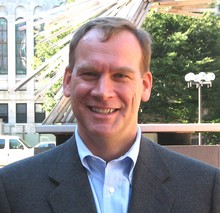Bennett Goldberg
Seeing Through Rock: How to Image Through Strongly Scattering Media

Biomedical Engineering/Physics
PROJECT DESCRIPTION
Imaging, or clearly seeing objects, requires the light from the object to travel without scattering or deviation from a straight path. We cannot normally image through thick fog, although light does pass, nor can we image through a glass of milk or tissue or other objects that scatter light. Our research is developing techniques to overcome scattering by pre-compensating the directions of the photons to account for the scattering and deviations of their paths in the material. We are currently working to image inside of rock. The project proposed for REU/RET partnership is to develop a model system of scattering using nanoparticles. Several ideas are proposed that we will explore together: First, we could embed nanoparticles into a stretchable plastic sheet. Initially, the sheet passes light, but not images, since the scattering is too strong. However, as the sheet is stretched, the nanoparticles separate and imaging is possible. Another idea is to make packings of different sized nanoparticles and measure how they scatter light.
REU STUDENT
Sarai Sherfield
LEARNING GOALS
• Background: Be able to use the methods of geometric optics, specifically ray tracing to form images using lenses. Build a simple imaging system on an optical rail and use it to form images, and to place various scattering materials in the way to destroy the images. Develop and understanding of why scattering affects imaging, be able to describe why one can’t see through fog or milk or tissue.
• Theory: Be able to describe how pre-compensating for scattering can overcome it and form images.
• Experiment: Help explore examples of scattering using nanoparticles, and apply these test systems to the imaging through strongly scattered media.
• Application: Develop an appreciation for photonics research. Understand where imaging through strongly scattered media can be useful to society.
Learn more about Professor Goldberg’s work at his lab website.